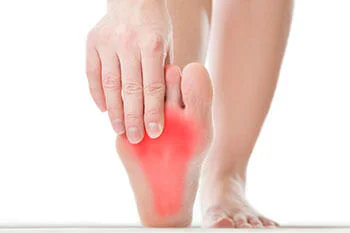Table of Contents
What is hallux rigidus?
Hallux rigidus is a mechanical arthritic condition of the big toe joint that, overtime limits toe bending motion. At first the condition is not particularly painful and only slightly limiting, but can progress to severe pain and complete joint degeneration with severe blockage of motion. A hallmark of the condition is a ridge of bone that develops on the top of the big toe joint (dorsal bunion). The ridge of bone is an arthritic spur that enlarges as the end of the first metatarsal bone (bone behind the big toe) flattens and loses shape.
While it can take years for the big toe joint to wear out, the destructive damage cannot be reversed. The condition has four stages of destruction, with each successive stage having more limitation and destruction of the joint. The final stage is hallux rigidus where the normal joint anatomy is fully destroyed.
What causes hallux rigidus?
Like many conditions in medicine it is sometimes difficult to clearly determine the cause of a problem. The following factors seem to be related to the genesis of the problem:
- Genetics (inherited poor foot structure or mechanics)
- Trauma to big toe (joint sprain, crush injury, dropped object)
- Arthritis (i.e. gout)
- Demanding activities
(crouching, sports, ballet) - Poor shoes
What are the non-surgical treatments?
The goal of any treatment is to slow the progression of the problem and relieve joint pain. The treatments listed below combined together can help to alter the mechanical stress at the big toe joint:
- Shoe Selection: Proper selection in shoes can be critical for preventing further damage to the joint and relieving pain. Selecting shoes with stiff, rocker bottom soles is an effective non-surgical treatment.
- Custom Orthotics: Custom orthotics can be very effective when combined with good supportive shoes. Over-the-counter support can be tried, but may be less effective than custom orthotics.
- Calf Stretching: This should be incorporated into a daily routine to decrease pressure at the ball of the foot.
- Modifying Activities: Changing activities can be an effective nonsurgical treatment. Consider bicycling instread of running. Make a conscious effort to kneel with your foot flat, instread of bending at the big toe. HIgh impact activities on the ball of your foot as well as crouching aggrivate the arthritis in the big toe joint and should be avoided.
- Arthritis treatments: Non-steroidal anti-inflammatory medication can be considered, but should be taken under medical guidance when used long-term due to side effects. Steroid may be injected into the joint, however the effects are usually temporary. Use of dietary supplements such as: glucosamine sulfate, chondroitin sulfate, and/or MSM (methylsulfonylmethane) may also be worth considering.
Is there a way to tell if my problem is progressing?
What can I expect with surgical treatments?
The type of surgery performed will depend upon the amount of joint damage that exists. In joints that show only mild or moderate damage, the joint can often be preserved; however, joint preservation may not be possible in more advanced stages. The doctors at Integrative Foot & Ankle Centers of Washington have treated patients throughout Washington State with this condition and are very familiar with the newest technques.
In the earlier stages of joint destruction, a cheilectomy (which means “to remove the lip”) is a procedure that may be initially recommended. The procedure cleans out the joint and removes the joint spur or lipping. The duration of relief varies from patient to patient and another surgery may be required at a later date. Sometimes a cheilectomy is combined with various types of bone cutting, or joint repositioning procedures to improve joint range of motion and to try to limit future joint jamming.
For those joints in end stage destruction one of three options below may be required:
- Joint fusion (arthrodesis): Although this option will eliminate joint motion, after surgery it can be insignificant as the joint is already very limited. It can be very effective in relieving pain, is durable and has a high patient acceptance.
- Joint implant: This is an option that is generally not as favorable when compared to fusion, since the pain can migrate to the second toe area and the implant can wear out and require the need for future surgery. Revision surgery then becomes more difficult due to the loss of bone.
- Arthroplasty (removing the joint): this is usually reserved for elderly patients who cannot risk prolonged periods of non-weightbearing after surgery.
If the condition is mild to moderate in severity and the joint can be saved, then various types of bone cutting, or joint repositioning procedures can be considered to improve joint range of motion and to try to limit future joint jamming. This procedure is usually combined with joint spur removal and cleanout (known as cheilectomy).
What to Do Next?
Surgery, if recommended, is typically performed on an out-patient basis at Swedish Medical Center or Providence Regional Medical Center, Everett and performed one foot at a time. The procedures may require use of bone screws to stabilize fusions or bone cuts. The surgery may require use of a cast and limited weightbearing until the bone has healed properly, usually around 6 weeks. However, full recovery may take 6 months or longer and may require some short term limitations in activities, especially in jobs that require standing or walking.
Contact us today to schedule an appointment.


